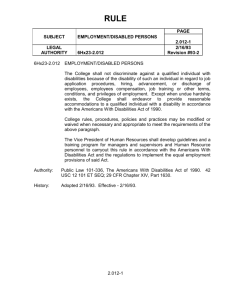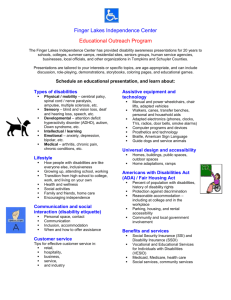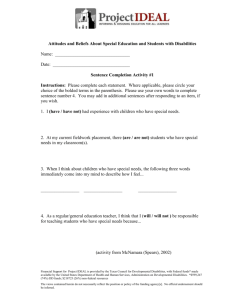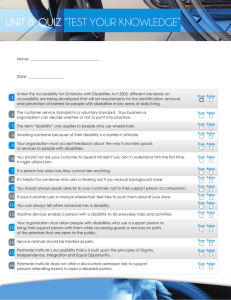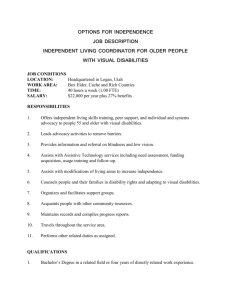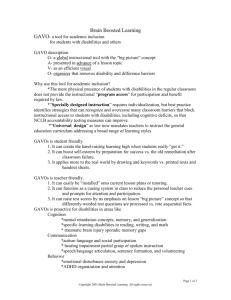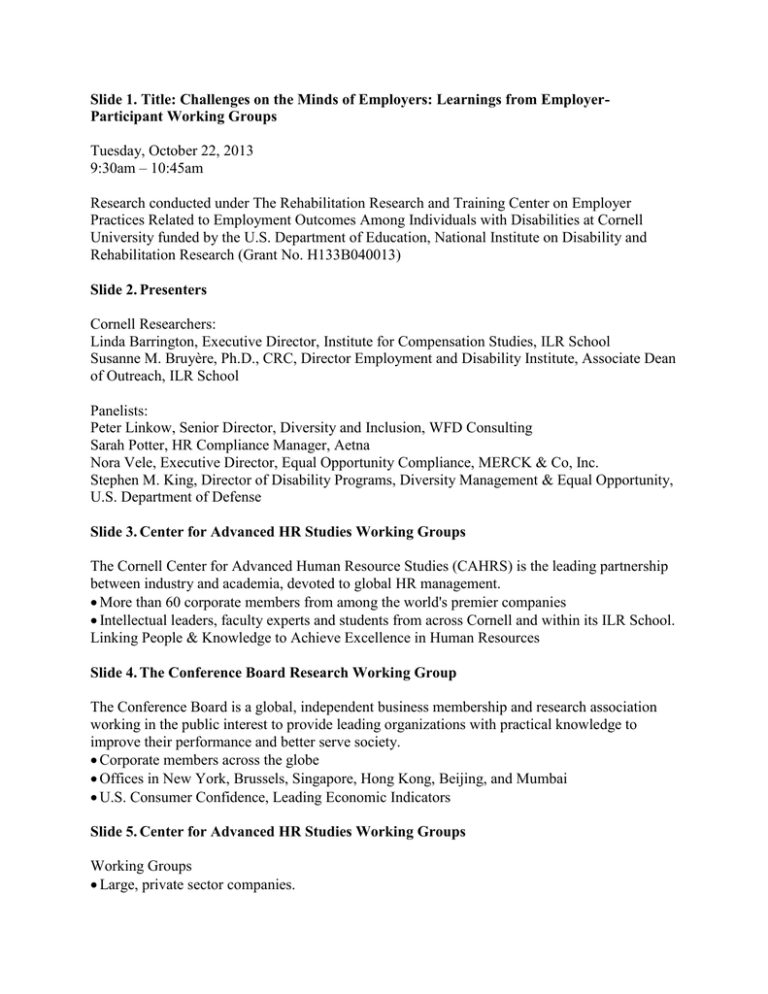
Slide 1. Title: Challenges on the Minds of Employers: Learnings from EmployerParticipant Working Groups
Tuesday, October 22, 2013
9:30am – 10:45am
Research conducted under The Rehabilitation Research and Training Center on Employer
Practices Related to Employment Outcomes Among Individuals with Disabilities at Cornell
University funded by the U.S. Department of Education, National Institute on Disability and
Rehabilitation Research (Grant No. H133B040013)
Slide 2. Presenters
Cornell Researchers:
Linda Barrington, Executive Director, Institute for Compensation Studies, ILR School
Susanne M. Bruyère, Ph.D., CRC, Director Employment and Disability Institute, Associate Dean
of Outreach, ILR School
Panelists:
Peter Linkow, Senior Director, Diversity and Inclusion, WFD Consulting
Sarah Potter, HR Compliance Manager, Aetna
Nora Vele, Executive Director, Equal Opportunity Compliance, MERCK & Co, Inc.
Stephen M. King, Director of Disability Programs, Diversity Management & Equal Opportunity,
U.S. Department of Defense
Slide 3. Center for Advanced HR Studies Working Groups
The Cornell Center for Advanced Human Resource Studies (CAHRS) is the leading partnership
between industry and academia, devoted to global HR management.
More than 60 corporate members from among the world's premier companies
Intellectual leaders, faculty experts and students from across Cornell and within its ILR School.
Linking People & Knowledge to Achieve Excellence in Human Resources
Slide 4. The Conference Board Research Working Group
The Conference Board is a global, independent business membership and research association
working in the public interest to provide leading organizations with practical knowledge to
improve their performance and better serve society.
Corporate members across the globe
Offices in New York, Brussels, Singapore, Hong Kong, Beijing, and Mumbai
U.S. Consumer Confidence, Leading Economic Indicators
Slide 5. Center for Advanced HR Studies Working Groups
Working Groups
Large, private sector companies.
Two meetings to-date. Third in 2014.
Hosted at a partner company.
Each focused on theme. Each 2/3 of day.
Facilitated roundtable discussion by CAHRS research faculty members.
Attraction, Retention, and Reward for Employees with Disabilities
New York City/Aetna
Organizational Culture and Employer Practices with Respect to Persons with Disabilities
San Francisco/Charles Schwab
10-12 Fortune 100 Level Corporations
Example titles: Director HR, Director Diversity & Inclusion, Compliance Manager, Diversity
Analyst, Manager Employee Engagement, Sr. Director Talent Acquisition, HR Generalist
Slide 6. The Conference Board Research Working Group
Research Working Group
Cross-industry. Public and private sectors.
Met three times. Each was two-day meeting.
Hosted at ILR-NYC and two member companies.
Facilitated discussion to shape report scope.
Invited speakers for deeper knowledge.
Peer-learning from members’ presentations on own practices.
Improving Employment for People with Disabilities
New York City/Cornell-ILR; Washington, DC/Lockheed Martin; Los Angeles/Mattel
Example Organizations
Goldman Sachs, KPMG, Mattel, Bayer,
NY Life Insurance, CVS Caremark, Lockheed Martin, Waste Management, Discovery
Communications
PA Dept. of Labor,
U.S. Dept. of Comptroller,
U.S. Dept. of Defense
Example Titles
Associate Director, Analyst,
Director HR, VP Diversity,
Exec Director Inclusion,
Manager Workforce Inclusion,
Supervisor Rehabilitation Specialist,
Integrated Marketing/Supply Chain
Slide 7. The Four Challenges
Business Case
Organizational Readiness
Self Disclosure
Measurement
Plus
Veterans
The Global Landscape
The Future of Employment of People with Disabilities
The Business Case
The Conference Board Research Working Group Innovative Research on Employment Practices:
Improving Employment for People with Disabilities
Slide 8. The Business Case
1. The Talent Pool
2. Costs
Workers’ compensation costs
Health care costs
Accommodation costs
Legal and related costs
3. Benefits
4. Growth in Revenue and Market Share
5. Work Group Performance
6. Financial Incentives
7. Fulfillment of Executive and Legislative Mandates
Slide 9. Organizational Readiness: Elements of Strategy
Image: A diagram representing a building. A roof is held up by six pillars. The pillars rest on a
flat base.
The base is labeled “Values and beliefs.”
The pillars are labeled:
Top management commitment
Communications
Integrative infrastructure
The employment process
Measurement and self-disclosure
Organizational climate
The roof over the pillars is labeled “Organizational Imperatives”
The image is © 2013 by WFD Consulting, Waltham MA, All rights reserved
End Image.
Slide 10. Organizational Readiness: The Employment Process
Figure: The Employment Process
A flowchart picts the stages of the employment process. The stages are: job descriptions,
identifying qualified employees, job advertisements and postings, application process,
preemployment tests, interviews, the offer, postoffer medical exams, onboarding, reasonable
accommodations, employee resource groups, mentoring, performance management, and career
development & advancement.
End Figure
Slide 11. Self Disclosure
Note: RWG before OFFCP issued new Section 503 final rules)
Why do employees not disclose?* (percent rating very important)
Risk of being fired/not hired: 73%
Employer may focus on disability: 62%
Risk of losing health care: 61.5%
Fear of limited opportunities: 61.1%
Supervisor may not be supportive: 60.1%
Who discloses?* (self define disability as):
Very apparent: 85.9%
Somewhat apparent: 79.1%
Not apparent: 74.1%
Who do they tell?** (Among the approximate ¾ who do disclose to someone at work)
Co-workers: 83%
Manager/Supervisor: 82%
Other staff or personnel: 56%
Other manager/supervisor: 55%
*Source: von Schrader, Malzer, Erickson, Bruyère, Emerging Employment Issues for People
with Disabilities, Cornell-ILR School, EDI
**Source: Kessler Foundation/NOD, The ADA, 20 Years Later, Harris Interactive, 2010
Slide 12. Self Disclosure (continued)
Are there negative consequences to disclosure?* (depending on how apparent their disability
was)
o Between 19.8% and 27% experienced longer-term negative consequences
o Between 6.9% and 10.1% experienced immediate negative consequences
Source: von Schrader, Malzer, Erickson, Bruyère, Emerging Employment Issues for People with
Disabilities, Cornell-ILR School, EDI
Slide 13. Self Disclosure (continued)
What questions should be asked to determine whether an individual has a disability?
Six Questions Adapted from the American Community Survey
1. Are you deaf or do you have serious difficulty hearing?
2. Are you blind or do you have serious difficulty seeing?
even when wearing glasses?
3. Because of a physical, mental, or emotional condition, do you have serious difficulty
concentrating, remembering, or making decisions?
4. Do you have serious difficulty walking or climbing stairs?
5. Do you have difficulty dressing or bathing?
6. Because of a physical, mental, or emotional condition, do you have difficulty doing errands
alone such as visiting a doctor’s office or shopping?
Purpose drives collection process drives degree of identification
Slide 14. Measurement
The Dilemma: Identifying “best practices”
Other than measures of the representation of people with disabilities, measurement typically
occurs at the broader diversity level
o Representation measures depend upon self-disclosure
o SHRM reported in 2010 that just over a third measured the impact of their diversity practices
Questions
How do you tie measures to organizational goals?
How do you measure when disabilities themselves are so diverse?
What is a realistic timeframe for seeing change?
What behaviors do we actually want?
What specific metrics will allow you to know if you’ve created a culture or climate in which
people with disabilities can thrive?
Slide 15. Measurement: Employment of People with Disabilities Scorecard
Figure: Employment of people with disabilities scorecard.
The scorecard is depicted as a wheel. In the center, the hub is labeled “Organizational
outcomes.” Around the center, the wheel is divided into five equal sections. The sections are
labeled: Accountability, Vendor Diversity, Work Environment/Culture, Representation Pipeline,
and Talent Development. Overall, the figure suggests that the five pieces or elements of a
scorecard should be linked, to the degree possible, with organizational outcomes.
End Figure
Slide 16. To obtain a free copy of the Executive Summary (12 pgs) or the full Research
Report (80 pgs),
Go to: Cornell – ILR School Digital Commons
http://digitalcommons.ilr.cornell.edu/edicollect/1292/
Note:
“Download” at this URL retrieves a PDF
The “Additional Files” Link at bottom of this URL leads to an accessible HTML version of
report.
Slide 17. CAHRS Working Group Summaries
Attraction, Retention and Reward for Employees with Disabilities
Oct. 14, 2011 | New York, NY
http://cahrs.ilr.cornell.edu/CentersofExcellence
Diversity and Inclusion
https://est05.esalestrack.com/eSalesTrack/Content/Content.ashx?file=54a9007c-6246-4fbc9c55-a269da23904f.pdf
Asking does make a difference
The challenge of inclusion on a global scale
Progress measured “In 5-10 years, how will we know that we’re doing a better job?”
Organizational Culture and Employer Practices with Respect to Persons with Disabilities
Feb. 15, 2012 - San Francisco, CA |Hosted by Charles Schwab
http://cahrs.ilr.cornell.edu/CentersofExcellence
Diversity and Inclusion
https://est05.esalestrack.com/eSalesTrack/Content/Content.ashx?file=4de0f9be-9dea-45009e71-c620531b3e3e.pdf
Importance of Employee Resource Groups
What gets measured, gets done “What is your organization doing to actually measure inclusion
[of employees with disabilities]?”
Slide 18. CAHRS Working Group Summaries
Questions in Need of More Solutions
What are more effective ways to engage advocates within the work environment for people
with disabilities?
How can the pipeline of college students with disabilities be strengthened?
How will progress goals be set within the new regulations for federal contractors?
How do we better encourage self-disclosure?
What are the barriers to employment for those with (government-defined) targeted disabilities
who are not yet in the labor force?
How do we expand the talent pool of people with disabilities?
Slide 19. Presenters
Cornell Researchers:
Linda Barrington, Executive Director, Institute for Compensation Studies, ILR School
Susanne M. Bruyère, Ph.D., CRC, Director Employment and Disability Institute, Associate Dean
of Outreach, ILR School
Panelists:
Peter Linkow, Senior Director, Diversity and Inclusion, WFD Consulting
Sarah Potter, HR Compliance Manager, Aetna
Nora Vele, Executive Director, Equal Opportunity Compliance, MERCK & Co, Inc.
Stephen M. King, Director of Disability Programs, Diversity Management & Equal Opportunity,
U.S. Department of Defense



